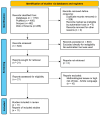Prevalence and Predictors of Diabetic Retinopathy in Saudi Arabia: Insights from a Systematic Review and Meta-Analysis
- PMID: 39766193
- PMCID: PMC11727158
- DOI: 10.3390/biom14121486
Prevalence and Predictors of Diabetic Retinopathy in Saudi Arabia: Insights from a Systematic Review and Meta-Analysis
Abstract
Background: Diabetic retinopathy (DR) is one of the leading causes of blindness among diabetic patients, particularly in areas with an increase in diabetes epidemics, such as Saudi Arabia. Notwithstanding the significant public health implications, data on the prevalence and risk factors of DR in Saudi Arabia are few and scattered, limited to certain geographic areas. Our study objective is to conduct a systematic review of the literature and a meta-analysis of the prevalence and predictors for DR in Saudi Arabia, within both type 1 and type 2 diabetes.
Methods: A systematic review and meta-analysis were constructed according to PRISMA guidelines. We searched PubMed, Embase, Web of Science, and Google Scholar electronic databases for studies published from 2000-2023. Any study related to the prevalence of diabetic retinopathy in T1DM or T2DM among adult patients aged ≥18 years that was conducted in Saudi Arabia was included. Pooling prevalence estimates were calculated using a random-effects model, and heterogeneity across the studies was tested by the I2 statistic and Cochran's Q test.
Results: A total of 11 studies published between 2006 and 2019 met the inclusion criteria, with sample sizes ranging from 99 to over 50,000 participants. The overall pooled prevalence of DR was estimated to be 31% (95% CI: 24-39%), with substantial heterogeneity observed across studies (I2 = 99%). Prevalence estimates ranged from 16.7% to 69.8% and were influenced by variables such as study design, duration of diabetes, and glycemic control. Among individuals with type 2 diabetes, the pooled prevalence was 24% (95% CI: 20-28%). Poor glycemic control and longer diabetes duration were consistently identified as significant predictors of DR, while other factors, such as obesity and hypertension, were also associated with an increased risk of DR.
Conclusions: The high prevalence of DR in Saudi Arabia highlights the critical need for focused public health initiatives, especially among those with type 2 diabetes. To minimize the effects of DR, early intervention, routine DR screening programs, and optimal diabetes control are essential. The increasing prevalence of DR in Saudi Arabia requires careful consideration of healthcare policy and resource allocation, which is made possible by our results.
Keywords: Saudi Arabia; diabetic retinopathy; glycemic control; meta-analysis; prevalence; public health interventions; risk factors; systematic review; type 1 diabetes; type 2 diabetes.
Conflict of interest statement
The authors declare no conflicts of interest.
Figures





References
-
- Magliano D.J., Boyko E.J., Committee IDA 10th Edition Scientific . IDF Diabetes Atlas. IDF; Brussels, Belgium: 2021. [(accessed on 16 November 2024)]. pp. 1–141. Available online: https://diabetesatlas.org/idfawp/resource-files/2021/07/IDF_Atlas_10th_E....
-
- Mokdad A.H., Jaber S., Aziz M.I.A., AlBuhairan F., AlGhaithi A., AlHamad N.M., Al-Hooti S.N., Al-Jasari A., AlMazroa M.A., AlQasmi A.M., et al. The state of health in the Arab world, 1990–2010: An analysis of the burden of diseases, injuries, and risk factors. Lancet. 2014;383:309–320. doi: 10.1016/S0140-6736(13)62189-3. - DOI - PubMed
Publication types
MeSH terms
LinkOut - more resources
Full Text Sources
Medical
Miscellaneous

